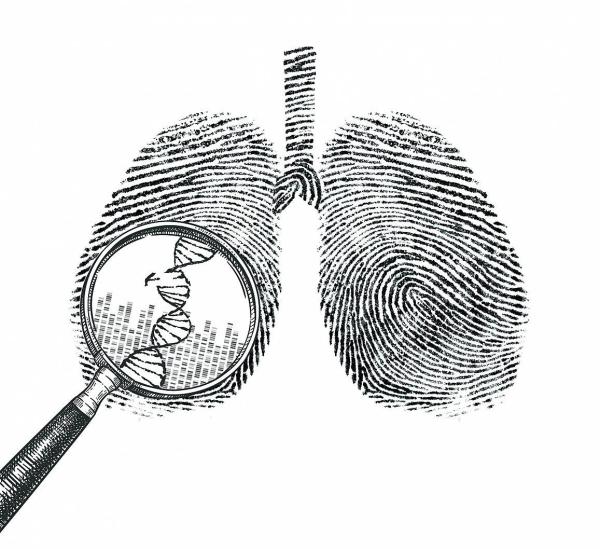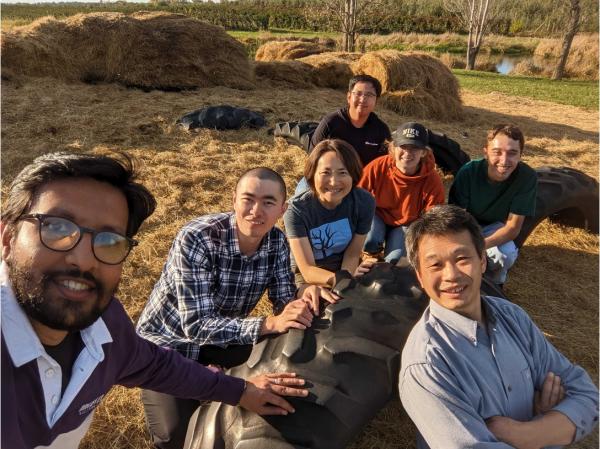Examining Genetic Influences on Lung Cancer
IRP Research Investigates Disease’s Roots Beyond Smoking

It’s common knowledge that smoking greatly increases the odds of getting lung cancer, but IRP researchers are attempting to determine how genes influence risk for the disease. Image credit: Dr. Maria Teresa Landi and the Sherlock-Lung Study team
Today is World Lung Cancer Day, bringing increased awareness to a disease most commonly associated with smoking tobacco products. Yet even though cigarette smoking rates have decreased over the past few decades, this deadly disease remains responsible for more deaths than any other type of cancer — more than 125,000 per year in the U.S. alone. In fact, between 10 and 25 percent of lung cancers occur in people who never smoked.
IRP Stadtman Investigator Jiyeon Choi, Ph.D., has always been curious about how our DNA influences the traits we have and our risk for diseases. When it comes to genes’ contribution to cancer risk, the stakes are particularly high, but Dr. Choi noticed a gap in research when it came to understanding the role genetic variation plays in lung cancer risk. She and her research team aim to fill this gap using a battery of high-tech genomic studies to root out the genes and molecular processes that make some people more susceptible to the disease.
“There aren’t many groups who are trying to connect the epidemiological findings on lung cancer to the molecular underpinnings of the disease,” Dr. Choi says. “By studying the genetics of how lung cancer happens, it is possible to provide clues and tools for early detection, when there’s a better chance of successfully removing the entire tumor. And if we know the cause of lung cancer, we can do a better job of prevention and screening, which could be particularly beneficial for non-smokers.”
Teasing out the separate effects of genetics versus smoking and other environmental factors like air pollution or exposure to asbestos has never been straightforward. Twin studies, family history analyses, and population genetics suggest that 8 to 20 percent of differences in lung cancer risk between individuals can be attributed to their genes. What’s more, epidemiological studies involving tens of thousands of patients and healthy individuals have linked roughly 50 different locations in our DNA to lung cancer, but this doesn’t tell us which gene variants are the actual culprits or what specific roles they play.

Even though environmental and behavioral factors like smoking have a strong association with the development of lung cancer, uncontrollable genetic influences still play a large — but understudied — role.
“Of course, if you inherit one variant, it doesn’t automatically give you lung cancer,” Dr. Choi notes. “It’s a genetic lottery, if you will, of multiple variants occurring in one person, which put them in a higher-risk group, and having more genetic variants may increase that risk. Even then, whether or not that person will develop cancer still depends on the interplay of genetics with environmental factors.”
Dr. Choi and her research team are working with several research groups at NIH and outside the U.S. to better understand the role genetic variants play in this complicated system. In one recent study, Dr. Choi and her NIH collaborators — IRP senior investigators Qing Lan, Ph.D., and Jianxin Shi, M.D., Ph.D. — peered through several huge data sets from participants of East Asian and European ancestry to find differences between the DNA of lung cancer patients and participants without cancer.1 More than half of the cancer patients in the Asian dataset had never smoked tobacco products. The research team discovered 12 previously unidentified genetic variants associated with increased susceptibility to lung cancer in the Asian participants; however, most of these genetic variations did not appear to affect lung cancer susceptibility in populations of European descent. Most notably, the genetic factors the analysis identified in the Asian participants seemed to have a greater influence on risk for lung cancer in patients who had never smoked than in those with a history of smoking.
In addition to sifting through the DNA of thousands of people, Dr. Choi’s team uses ‘high-throughput’ tools that examine the function of thousands of genetic variants simultaneously in multiple different types of cells. This is an important and time-saving approach because our lungs contain more than 50 different cell types, from the epithelial cells that line blood vessels in the lungs to the immune cells circulating in the blood itself. These cells all have different roles, and genetic variants could have different kinds of impacts in each type of cell.

Dr. Jiyeon Choi (third from the left) with members of her lab
Currently, Dr. Choi’s lab is collaborating on those studies with physicians in South Korea, where about 80 percent of women who have lung cancer do not have a history of smoking. That effort has involved examining the DNA and activity of genes in each and every cell in samples of lung tissue from over 130 South Korean lung cancer patients. The samples contained non-cancerous tissue that was collected during procedures in which an entire part of the lung is removed to combat the cancer. As expected, the connection Dr. Choi’s team observed between DNA and gene function differed greatly between different cell types, as well as between smokers and never-smokers.
“This interplay between all these cell types may explain why lung-cancer–associated genetic variants function differently in specific contexts,” Dr. Choi says. “We found some very good leads. Now we’re looking forward to looking deeper at the individual genes and gene locations along the DNA to figure out how they work.”
Dr. Choi believes her team is well-positioned to unlock the mysteries of that genetic and cellular interplay, in part, due the rich expertise available at NIH in fields from molecular biology and genetics to computational biology and statistics. Just as the lungs are made up of many varieties of cells with distinct functions, and lung cancer stems from an interplay of multiple contributing genetic and environmental factors, many scientists from diverse disciplines are needed to root out the origins of lung cancer.
“There’s not a single project in our group done by one person — that’s not possible,” Dr. Choi says. “We always work together to bridge these different fields, and with luck, eventually, we may find a causal link between the genetic variants and disease.”
Subscribe to our weekly newsletter to stay up-to-date on the latest breakthroughs in the NIH Intramural Research Program.
References:
[1] Shi J, Shiraishi K, Choi J, Matsuo K, Chen TY, Dai J, Hung RJ, Chen K, Shu XO, Kim YT, Landi MT, Lin D, Zheng W, Yin Z, Zhou B, Song B, Wang J, Seow WJ, Song L, Chang IS, Hu W, Chien LH, Cai Q, Hong YC, Kim HN, Wu YL, Wong MP, Richardson BD, Funderburk KM, Li S, Zhang T, Breeze C, Wang Z, Blechter B, Bassig BA, Kim JH, Albanes D, Wong JYY, Shin MH, Chung LP, Yang Y, An SJ, Zheng H, Yatabe Y, Zhang XC, Kim YC, Caporaso NE, Chang J, Ho JCM, Kubo M, Daigo Y, Song M, Momozawa Y, Kamatani Y, Kobayashi M, Okubo K, Honda T, Hosgood DH, Kunitoh H, Patel H, Watanabe SI, Miyagi Y, Nakayama H, Matsumoto S, Horinouchi H, Tsuboi M, Hamamoto R, Goto K, Ohe Y, Takahashi A, Goto A, Minamiya Y, Hara M, Nishida Y, Takeuchi K, Wakai K, Matsuda K, Murakami Y, Shimizu K, Suzuki H, Saito M, Ohtaki Y, Tanaka K, Wu T, Wei F, Dai H, Machiela MJ, Su J, Kim YH, Oh IJ, Lee VHF, Chang GC, Tsai YH, Chen KY, Huang MS, Su WC, Chen YM, Seow A, Park JY, Kweon SS, Chen KC, Gao YT, Qian B, Wu C, Lu D, Liu J, Schwartz AG, Houlston R, Spitz MR, Gorlov IP, Wu X, Yang P, Lam S, Tardon A, Chen C, Bojesen SE, Johansson M, Risch A, Bickeböller H, Ji BT, Wichmann HE, Christiani DC, Rennert G, Arnold S, Brennan P, McKay J, Field JK, Shete SS, Le Marchand L, Liu G, Andrew A, Kiemeney LA, Zienolddiny-Narui S, Grankvist K, Johansson M, Cox A, Taylor F, Yuan JM, Lazarus P, Schabath MB, Aldrich MC, Jeon HS, Jiang SS, Sung JS, Chen CH, Hsiao CF, Jung YJ, Guo H, Hu Z, Burdett L, Yeager M, Hutchinson A, Hicks B, Liu J, Zhu B, Berndt SI, Wu W, Wang J, Li Y, Choi JE, Park KH, Sung SW, Liu L, Kang CH, Wang WC, Xu J, Guan P, Tan W, Yu CJ, Yang G, Sihoe ADL, Chen Y, Choi YY, Kim JS, Yoon HI, Park IK, Xu P, He Q, Wang CL, Hung HH, Vermeulen RCH, Cheng I, Wu J, Lim WY, Tsai FY, Chan JKC, Li J, Chen H, Lin HC, Jin L, Liu J, Sawada N, Yamaji T, Wyatt K, Li SA, Ma H, Zhu M, Wang Z, Cheng S, Li X, Ren Y, Chao A, Iwasaki M, Zhu J, Jiang G, Fei K, Wu G, Chen CY, Chen CJ, Yang PC, Yu J, Stevens VL, Fraumeni JF Jr, Chatterjee N, Gorlova OY, Hsiung CA, Amos CI, Shen H, Chanock SJ, Rothman N, Kohno T, Lan Q. Genome-wide association study of lung adenocarcinoma in East Asia and comparison with a European population. Nat Commun. 2023 May 26;14(1):3043. doi: 10.1038/s41467-023-38196-z.
Related Blog Posts
This page was last updated on Monday, August 21, 2023
